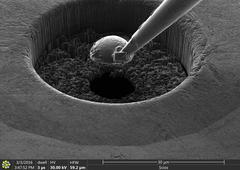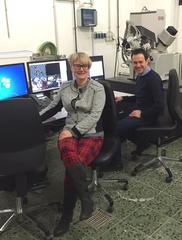URL: https://www.desy.de/news/news_search/index_eng.html
Breadcrumb Navigation
DESY News: New focused ion beam strengthens nano and high-pressure science
News
News from the DESY research centre
New focused ion beam strengthens nano and high-pressure science
A new “nano scalpel” enables scientists at DESY to prepare samples or materials with nanometre precision while following the process with a scanning electron microscope. The Focused Ion Beam, or FIB, microscope which has now gone into service also allows a detailed view of the inner structure of materials. The device was purchased by the University of Bayreuth, as part of a joint research project on the DESY campus funded by the Federal Ministry of Research. The FIB will be operated at the DESY NanoLab jointly with the University of Bayreuth.

Preparation of a double-staged diamond anvil cell with the focused ion beam microscope. Credit: Leonid Dubrovinsky, Universität Bayreuth

Natalia Dubrovinskaia and Thomas Keller in front of the new focused ion beam microscope at DESY. Credit: Sylvain Petitgirard, Universität Bayreuth
In addition, the device allows researchers to investigate the chemical composition of samples by measuring fluorescent radiation. “Together with the built-in milling machine, we can not only determine the three-dimensional structure, but also the distribution of the elements beneath the surface by alternately removing material and carrying out a chemical analysis, much like in 3D tomography,” adds Thomas Keller who heads the sub-division microscopy and nano structuring at the DESY NanoLab.



